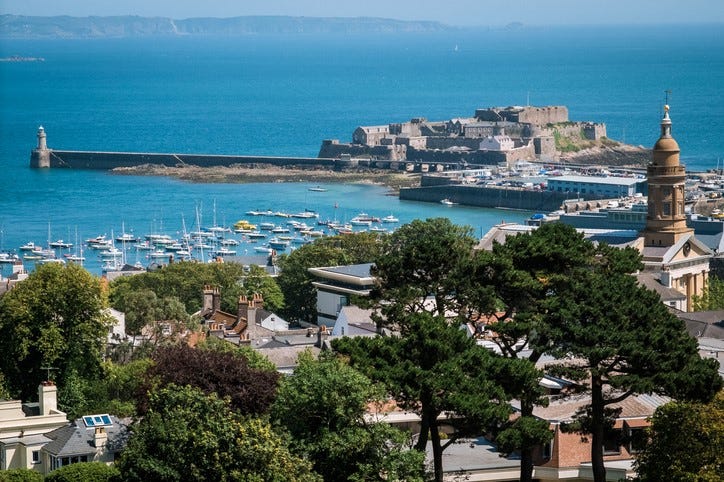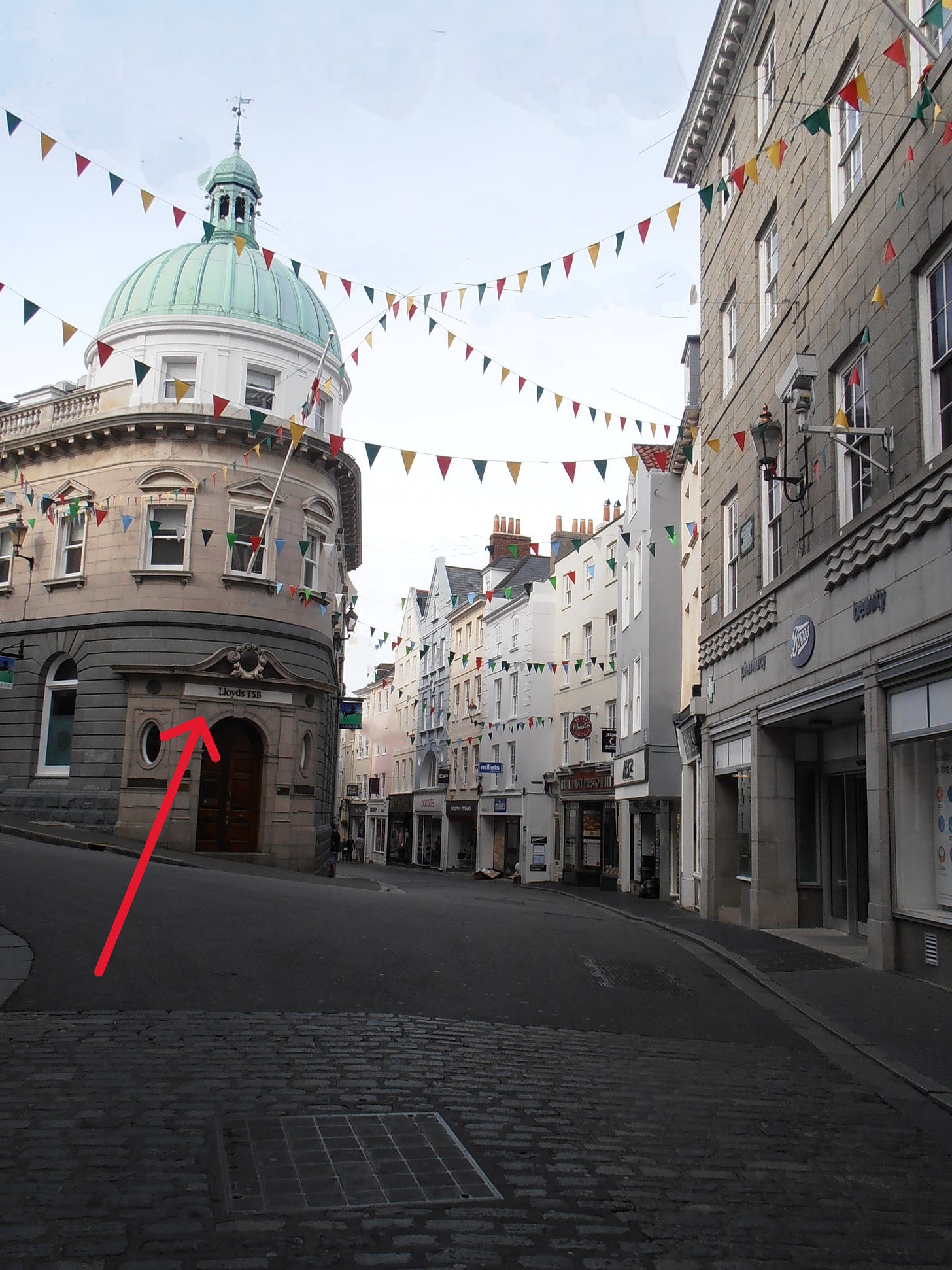Do you know anyone who has Guernsey, Channel Islands on the top of their bucket list? Paris, Rome, London, Tokyo, Sydney, Buenos Aires? You betcha! Guernsey? Nary a one.
Unless you are British, French, or a geography wizard, you might even need help finding Guernsey on the world map. Understandably. With a total land area of only 24 square miles (62 sq km), it is easy to blink and completely overlook Guernsey. Although the island is a British Crown Dependency, Guernsey’s roots run deep with France, as it is located a mere 30 miles (48 km) northwest of the French coast of Normandy in the English Channel. In fact, only 24% of Guernsey’s total population of 64,100 claims to be of British descent.
A popular weekend getaway destination for British and French vacationers, Guernsey does not attract many gals from East Texas. However, I’m almost a Guernsian by proxy. My paternal grandmother was born there in 1898, and her Guernsey family roots date back almost to the dawn of time. Well, okay… they only pre-date surviving records. My grandmother’s family bid farewell to Guernsey when she was a child and moved their young family to Toronto, Canada. Within the same time period in 1905 – 1906, my maternal grandmother’s family relocated from Scotland to Canada, and Guernsey, Channel Islands was their final port of departure as well. It’s a wonder both my grandmothers weren’t on the ship!
With no more than a few names to work with, my sister traced our family tree and diligently kept digging through records until she had the full scoop on our ancestors. She did verify our grandmothers were NOT on the same ship. Curiosity sent us on a quest to Guernsey to get a first-hand look at our historical roots.
We took a taxi from the airport to our hotel and good fortune was with us. Our driver was a retired gentleman named Dickie, who drove a cab a few days a week for the sport of it and to give his dear wife some breathing space.
Dickie was quite amused by our mission; although not enough to volunteer to be our personal driver and Guernsey tour guide the next day. However, my sister and I got along famously with Dickie, so we gave it our best shot and persuaded him that he was the PERFECT man for the job. Seriously, the guy was outnumbered, so what choice did he have? The next morning Dickie’s taxi was fired up and waiting for us at the front door of our hotel.
First on the agenda, a quick tour of St. Peter Port, Guernsey’s largest city. The city’s history dates back to the 13th century when the Castle Cornet was built to protect merchant ships anchored in the harbor after the Channel Islands separated from Normandy in 1204 AD. Over the centuries, the area has grown and expanded to become a modern city with a population of 18,950, recognized as a favored vacation resort, tax haven, and seaport.
Dickie was better than having our own personalized encyclopedia showing us the sights of Guernsey and answering our questions. Furthermore, he had a delightful personality and a great sense of humor! That’s as good as it gets for two gals snooping around the roots of the family tree.
Tragedy descended upon the Channel Islands during WWII when Nazi Germany invaded and overtook them on June 30, 1940. After France fell to Germany during the war, the British government offered some assistance to help 23,600 Channel Islanders evacuate to England. However, Winston Churchill’s government decided NOT to take defensive action against the Nazis to protect the Channel Islands. Consequently, Guernsey was under Nazi occupation and control for five years. Finally, in the early morning hours of May 9, 1945, HMS Bulldog sailed into St. Peter Port Harbor to liberate Guernsey. German officers boarded the ship and signed an unconditional surrender that ended the Nazi occupation of Guernsey. The Channel Islands was the ONLY European-located area connected to the British Empire that was occupied by Nazi Germany during WWII.
On a brighter note, Guernsey is world-renowned for its SUPERIOR MILK COWS. And don’t forget, my grandmother’s family lived there from the time the dinosaurs roamed the earth until they boarded that Canadian-bound ship docked at St. Peter Port Harbor at the turn of the 20th century.
Some of the sites my sister had earmarked for our ancestorial quest simply no longer existed. Dickie couldn’t do much about those, but he sure gave it a good team effort! He was able to zero in on several places of interest, based on my sister’s meticulous research and notes.
There it was, the home of a long-gone ancestor of ours, and it had obviously been remodeled. I zipped across the street, trying to look inconspicuous and nonchalant as I snapped a photo of the place. I felt like an incognito spy.
The pretty townhouse was directly across the street from the exact spot in St. Peter Port’s Cambridge Park where the last PISTOL DUEL in Guernsey took place on February 13, 1795. As the story goes, Major William Byng of the 92 Regiment of Foot accused the Regiment’s Surgeon, James Taylor of being disrespectful and unpatriotic because he didn’t stand when a band played the national anthem. Taylor claimed he did not recognize the band’s rendition of the anthem.
Byng became so snarky and enraged about the alleged lack of patriotism that he challenged Taylor to a pistol duel in Cambridge Park at sunrise the following morning. Ironically, pistol dueling was prohibited in Guernsey, so those wishing to snuff each other out generally took their rowboats over to the nearby island of Jersey to do their blasting. However, these two guys decided to do their dirty work right at home. They tossed their friendship and regiment loyalty aside and met in Cambridge Park at the crack of dawn, just a stone’s throw away from my long-gone ancestor’s front door. Taylor took Byng out with a solid shot in the noggin. The matter was settled. An old elm tree with Byng’s name carved in it was felled and replaced with the following commemorative plaque in 1971.
The next dwelling on our agenda was substantially less affluent. As with most families, there were a few skeletons hidden in the closet. Over on the other side of town, a young couple got married and had a couple of kids. And then they had a few more. And a few more. And, Lord help the woman, they kept on having kids until the poor soul went stark-raving crazy! Over the edge and out of her ever-loving mind!
She needed to be institutionalized in what was called an “insane asylum” in those days. However, according to the archaic laws of the time, if a wife needed to be admitted to an asylum, she had to go to the facility closest to her husband’s hometown. Mrs. Gone-Whacko’s husband was from Southern England. So Mr. & Mrs. Whacko farmed their whole brood of children off to the care of a children’s home and made haste for the looney bin in England. Life became rather grim for all those little long-gone ancestors of mine after their parents left them to fend for themselves in Elm Cottage.
.Every Sunday the children went to church at St. John, The Evangelist Church of England, the family’s home church. Weddings, funerals, and baptisms all took place here.
Guernsey is a small island. We certainly had the opportunity to walk in the family's footsteps.
Dickie saved my very favorite place in Guernsey, Channel Islands for our last stop in the day. Read about it in the next posting of Expect the Unexpected.

















Wonderful stories! And great pictures! So glad you coved the cows. Recommending!
Really interesting. Interesting that 2 kinds of cows are named after neighboring islands - Guernsey and Jersey.